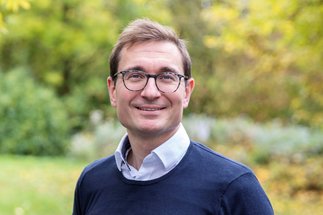Department of Biochemistry and Synthetic Metabolism
Mission Statement of our Department: Understanding and building new biology for a sustainable tomorrow

Although invisible to our eye, microorganisms are key to our climate. Microbes capture more than 120 billion tons of the greenhouse gas CO2 per year, which is a third of the annual CO2 cycle of our planet. They bind CO2 in form of biomass that can serve as food, raw material, or energy carrier to fuel life on Earth. This makes microbes “true masters of metabolism”, which carry the potential to provide new solutions to create a sustainable world of tomorrow.
The mission of the Department of Biochemistry and Synthetic Biology is to understand the fundamental principles of microbial carbon conversions. Beyond a mere understanding, we want to use our knowledge to create novel biocatalysts and processes for improved carbon capture that nature has not evolved (yet). In the future, this will allow us to realize new biological and bioinspired processes for the enhanced capture of CO2, such as an artificial photosynthesis or synthetic chloroplasts.
Central Questions & Methods
Currently, our research revolves around the following questions:
- How do microbes capture CO2? To that end, we study the corresponding biocatalysts at the molecular, cellular, and environmental level (i.e., study the natural “metabolic software” of CO2 fixation).
- How did nature evolve these CO2 capturing processes, and which opportunities did nature miss? To that end, we re-vive billions of years-old ancestors of these enzymes. In a complementary approach we use synthetic biology to design completely new alternatives for CO2 fixation that are better than the naturally evolved ones (i.e., develop a new “metabolic software” for carbon fixation).
- How do we implement and operate new CO2 capturing solutions inside of living cells? To that end we develop new methods to engineer and evolve different microorganisms, photosynthetic algae, and even plants for improved CO2 uptake (i.e., boot the “metabolic software” in living cells).
- How do we create new possibilities for bioinspired CO2 fixation processes outside of living cells? To that end, we assemble in vitro metabolic networks, artificial chloroplasts and minimal cells for CO2 capture (i.e., develop “new cellular hardware” to operate our “metabolic software”), and power them with new energy sources, such as electricity.
To tackle these questions, we use a highly inter- and transdisciplinary approach and a variety of different methods including protein biochemistry, molecular & structural biology, NMR and UV/Vis spectroscopy, metabolic & genetic engineering, experimental evolution and lab automation, metabolomics, transcriptomics & proteomics, synthetic biology, in vitro transcription translation, microfluidics, and machine learning.
Collaborations & Outreach
Embedded in a network of collaborations, we work closely with researchers from other institutions, for example in France, Switzerland, the Netherlands, Israel, Chile and the USA. Besides the fundamental research, we also collaborate with industrial partners, from start-ups and SMEs to global corporations.
Importantly, our science does not stop at the lab door, we are also strongly engaged in knowledge transfer and outreach. Together with the MPG, we developed materials for teaching (Biomax Künstliche Fotosynthese), collaborate with the Green Science Lab and Kindergartens and offer “meet-a-scientist” opportunities.
More about our research
Portait of Tobias Erb
Re-inventing photosynthesis
Biological energy from electricity
Building a synthetic chloroplast






